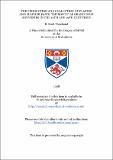Files in this item
The production and collecting of plaster and sulpher paste "impronte" as Grand Tour souvenirs in the 18th and 19th centuries
Item metadata
| dc.contributor.author | Marchand, K. Scott | |
| dc.coverage.spatial | 165 p. | en_US |
| dc.date.accessioned | 2018-07-12T16:58:18Z | |
| dc.date.available | 2018-07-12T16:58:18Z | |
| dc.date.issued | 1998 | |
| dc.identifier.uri | https://hdl.handle.net/10023/15337 | |
| dc.description.abstract | Whilst investigating the origins and nature of impronte, it became increasingly obvious that as objects in and of themselves, very little comprehensive work had been done to address questions of where, how, and why these objects came to be made. Initial inquiries to various museums and individuals demonstrated that these were not particularly rare items, they were abundant, and commonplace but little understood as objects of art. Typically, impronte are considered to be representations of gemstones, this work is intended to demonstrate that there is a broader dimension to the subjects depicted by impronte. Chapter one contains a brief overview of the historical context of gem collecting and the traditional processes of working on hardstones. The 18th century revival of interest in classical knowledge was directly responsible for the resurgence in the interest in amassing collections of ancient gemstones; as well as the collection of modern gemstones carved in the manner of the ancients. This revival, while stimulating renewed interest in gemstones, was so lucrative that it also encouraged numerous forgeries to be made. The quantity and quality of forgeries was to ultimately undermine confidence in the authenticity of gemstones and result in a collapse of the popular market for the collecting of gemstones, and by extension, impronte. Chapter two is an examination of the practical issues relating to the materials, manufacture, and conservation of impronte. The materials commonly encountered are sulpher and plaster, on rare occasion, glass paste. A large portion of the chapter is devoted to the different aspects of manufacturing impronte. Other sections are concerned with the problems relating to the conservation, storage and cleaning of impronte in the museum environment. Chapter three is an overview of the biographical details and commercial activities of the known makers of impronte represented in private and public collections in the UK and elsewhere. Chapter four is a discussion of the variety of themes and subjects portrayed on impronte. There is a wide diversity of subject material contained in sets of impronte, and not all are strictly pertinent to the traditional subjects treated by gemstones. Large numbers of impronte are intended to be visual study aids, and souvenirs, of great works of art, both ancient and modern held in various famous collections popular with 'Grand tourists'. In many instances impronte are more similar to an 18th and 19th century version of a postcard, or slide package, purchased by modern museum visitors and art lovers. The four appendices contain information about the collection of impronte at the Ashmolean Museum, Oxford; details from 19th century guidebooks to the artisans of Rome, written by Heinrich Keller; a catalogue of the collection of Paoletti impronte at the University of St Andrews; and sample details of the conservation survey of the Ashmolean collection. | en_US |
| dc.language.iso | en | en_US |
| dc.publisher | University of St Andrews | |
| dc.subject.lcc | NK5735.M2 | en |
| dc.subject.lcsh | Plaster sculpture. | en |
| dc.title | The production and collecting of plaster and sulpher paste "impronte" as Grand Tour souvenirs in the 18th and 19th centuries | en_US |
| dc.type | Thesis | en_US |
| dc.type.qualificationlevel | Master of Philosophy (MPhil) | en_US |
| dc.type.qualificationname | PhD Doctor of Philosophy | en_US |
| dc.publisher.institution | The University of St Andrews | en_US |
This item appears in the following Collection(s)
Items in the St Andrews Research Repository are protected by copyright, with all rights reserved, unless otherwise indicated.

